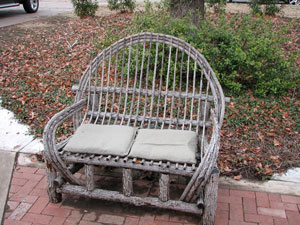Resource Library
Plant of the Week: Willow Furniture, Bentwood
The University of Arkansas System Division of Agriculture does not promote, support or recommend plants featured in "Plant of the Week." Please consult your local Extension office for plants suitable for your region.
Plant of the Week
Bentwood willow furniture
Latin: Salix

Once my parents were beyond my hearing, I thought of a thousand questions I wish I had asked them. One was about a comment made in passing by my mother about a California relative – presumably forced west by the Depression and the Dust Bowl years – who returned east for a visit in the 1950s. The relatives funded the trip by stopping along the roadway, harvesting native willows and building willow furniture on the spot to sell or trade for what they needed. Though this sounds quaint today, such resourcefulness is embedded deeply in the fabric of the American spirit.
About 400 species of willows (Salix) are described in temperate places in the northern hemisphere where species can be found with similar frequency in Asia, Europe and North America. Mostly we think of them as deciduous trees but they range in size from broad spreading creeping groundcovers of the Arctic region only growing a few inches tall to low branched shrubs to trees reaching 50 feet or more in height.
Willow – probably because of its abundance, easy workability and relative durability – was one of the first woods used by Europeans in building useful products and tools. An 8,300-year-old fishing net was found in a northern European bog made from willow stems. Willow baskets of similar vintage are also known. Willow and waddle construction – willow branches woven together and daubed with a mixture of mud, horsehair and straw – is still used in parts of the world as a basic and long lasting building method.
Though it seems that willow chairs would be an old woods craft of poor people, it is really an outgrowth of the Victorian period. Rustic furniture as a category became popular in America during the closing years of the 19th century when the “Great Camps” – palatial summer playgrounds of the rich and famous in the Adirondacks of New York – became part of the social fabric of the era. Bentwood furniture is mostly made of willow and was one of the styles that were imported from England during the period. The English had imported the style from the Orient in the early years of the Victorian era when anything with an Oriental feel was much en vogue.
The first wave of rustic furniture making was by skilled artisans, but the economic crash of the Depression saw common folk begin to make pieces from found or naturally occurring material they could either sell or barter. Soon after the end of WWII, the demand for rustic furniture dried up as “modern” furniture swept the nation. The use of rustic furniture – especially bentwood willow chairs for use in the garden – revived in the 1990s and remains with us as either a do-it-yourself craft addition for the garden of something that can be found at roadside stands around the country.
In Europe, most willow used in basketry and furniture making was produced by coppicing willow trees. In this procedure an established willow is cut close to the ground and the stump allowed to regrow. These new shoots are harvested every year or two depending on the size of branches needed. Coppicing, though it sounds severe, doesn’t affect the health of most broadleaf trees and trees grown in this fashion can continue production for generations. Willow is not an especially good decay resistant wood and a 10-year life span is about all you can expect if the furniture is in ground-contact and left exposed to rain. If kept dry and not abused it can have a long, useful life.
By: Gerald Klingaman, retired
Retired Extension Horticulturist - Ornamentals
Extension News - January 25, 2013
The University of Arkansas System Division of Agriculture does not maintain lists of retail outlets where these plants can be purchased. Please check your local nursery or other retail outlets to ask about the availability of these plants for your growing area.